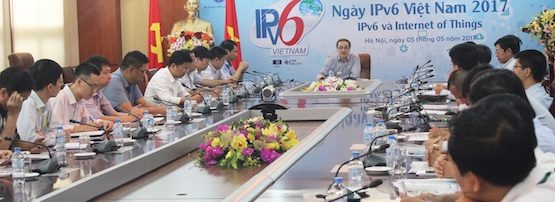
IPv6 and the Internet of Things (IoT) have been hot topics in Viet Nam for quite some time. Much has been discussed about the evolution of IoT and devices but less about the role of IPv6 as a means to support it.
These were among the areas addressed by the “IPv6 and Internet of Things” conference, hosted by Viet Nam’s National IPv6 Task Force (IPv6TF) earlier this month.
Conference chair, Mr Phan Tâm, Deputy Minister of the Ministry of Information and Communications (MIC), was one of the many dignitaries at the event, which was held in commemoration of Viet Nam IPv6 Day 2017 on 5 May.
To provide attendees with some context, the Vietnam Internet Network Information Center gave a brief presentation about the nature of IoT and IPv6 as part of Viet Nam’s National IPv6 Action Plan, including recently updated policies that Viet Nam is adopting for IoT and IPv6 enterprises.
These policies specify that local businesses deploying IPv6 and investing in IoT technologies may be eligible for benefits. These include exemption from corporate tax during the first four years and a 50% reduction of corporate tax in the following nine years for activities including the manufacturing of software, investment, and research and development of IPv6 products; exemption of import tax for all materials, spare parts and components that are used for the manufacturing of IPv6 products; and exemption of VAT for imported goods and equipment used for IPv6 deployment.
Speakers from major Internet service providers, including VNPT Technology and FPT Telecom, delivered presentations about their research and achievements in the field of IoT, and discussed their plans for deploying IPv6 to enable their organizations and customers to implement new era technologies.
It’s been almost a year since FPT Telecom became the first ISP in Viet Nam to offer IPv6 services, in which time they have connected almost one million of their users.
In his concluding remarks, Mr Tâm emphasized that IPv6 was a crucial solution for meeting the demand of development, security, scalability, and connectivity for the IoT. However, to follow the steps of the global IoT trends, more needs to be done — outside of regulations and policies — by government authorities, ISPs, CSPs, and IoT enterprises.
The “IPv6 and Internet of Things” conference was part of the ongoing efforts by the IPv6TF to develop awareness of and help businesses plan for and deploy IPv6. More than 100 people attended the conference, including members of the IPv6TF, representatives of MIC and several other governmental authorities, major local ISPs and mobile service providers, local IoT solution providers, and the media.
Mai Thu Thuy manages the Vietnam Internet Network Information Center’s communications team.
The views expressed by the authors of this blog are their own and do not necessarily reflect the views of APNIC. Please note a Code of Conduct applies to this blog.
